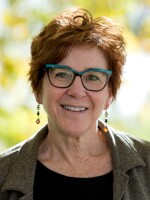This article first appeared in the St. Louis Beacon, Jan. 2, 2012 - As an undergraduate studying art history at the University of Wisconsin, African art was hardly on the radar of Kristina Van Dyke, new director of the Pulitzer Foundation for the Arts. But while working on her degree in Western art, she took an African art class to fulfill a requirement.
Progressing through graduate school at Williams College in Williamstown, Mass., Van Dyke felt an increasingly strong pull toward African works and their history. By the time she got to Harvard, her goal was to earn a Ph.D. in African art.
"I kept getting distracted by African art and I finally decided to go for it," Van Dyke said.
Expect Van Dyke's specific interest and expertise to influence the Pulitzer as she begins to take the institution into its second decade. Van Dyke talked with the Beacon about what's ahead for the Pulitzer and what she likes about St. Louis.
Are any African art exhibits coming soon?
Van Dyke: Something in the near term is a collaborative project I was working on as the curator for collections and research at the Menil Collection in Houston called "Love and Africa." I have been working on it with a colleague in Lagos, Nigeria, named Bisi Silva, the director for the Center for Contemporary Art in Lagos. This project will also now appear at the Pulitzer next fall so it will open at all three institutions [Menil, Lagos Center and Pulitzer] at the same time.
What's "Love and Africa" about?
Van Dyke: It explores love and questions about love such as, what kind of love is timeless and universal, and what part of love is culturally and historically specific? We're looking at the nature of love and how love is shaped and made possible through various systems like media -- things like telephones, cell phones, the internet, the printed word and movies.
Here, we are very early in the development of the exhibition but we'll be working with something very specific to the Pulitzer. In Houston, I hope to have the work of an artist named Zoulikha Bouabdellah who writes Arabic words for love on individual pieces of paper and then creates this grid-like installation of them. There are over 300 words. That really speaks about language as a kind of system that moves ideas around and also shapes them.
Another work, by an artist named Munir Fatmi, brings together a group of books: religious texts, the Koran, the Bible and philosophical texts, all in Arabic and Western European languages. He wires these all together, and this really alludes to the power of not only the printed word and what the printed word has meant over time and the dissemination of ideas but also what happened when these ideas were made available electronically through the internet.
The way these are wired together makes it a very ambivalent piece. On the one hand, it speaks to connectivity and the power of the dissemination, and on the other hand, it speaks to the explosive potential for ideas moving around and the kind of explosive power that ideas have in new contexts.
With you at the helm, what might be the course of the Pulitzer's future?
Van Dyke: What drew me to work at the Pulitzer and what really excites me about it is that you can combine social work, an interest in Asian art, psychology and religion; it's a very ideas-oriented place.
If you look at the "Dreamscapes" exhibition this summer, it showed a real interest in the history of psychology. "Reflections of the Buddha" shows an interest in Asian art and art supporting a spiritual practice. The Pulitzer is also an institution that has collaborated with social service providers in St. Louis to bring about the "Staging Old Masters" program.
My colleagues and I are going through the last 10 years very systematically so we can think about the next 10 years. We're having a substantive conversation about which things worked well, given our kind of scale and resources, and our relationships with other institutions.
Our program will be become increasingly refined but will remain highly experimental. It's kind of exciting.
What are your impressions of St. Louis and its arts community?
Van Dyke: It's a really exciting time to be here because, of course, the St. Louis Art Museum will open its expanded facilities in the next year or two. It has a great reputation as a encyclopedic institution.
I knew some of my colleagues there prior to arriving and have met many others since. It is a welcoming and collegial group of scholars, and the same can be said for the Contemporary Art Museum. It's a very young institution and it's exciting to be next door.
St. Louis is a very easy place to move to, very open and cordial. It's a good-looking city; I feel excited about the presence of historical architecture, the parks, the interest in gardening and organic farming such as Winslow's Home or Cafe Osage where you see this combination of a restaurant and garden where you can buy produce.
What about the more traditional St. Louis foods like Ted Drewes and toasted ravioli?
Van Dyke: Are you trying to get me in trouble? I'm not going say anything damning about fried ravioli; I haven't tried it yet -- but I promise I will.

